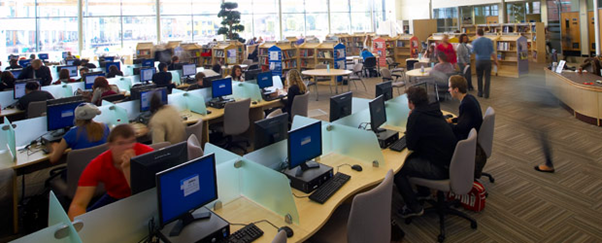Windows 7 Deployment a look at the real world
WIM’s, WDS, SCCM, WAIK, MDT, VAMT, MAK and KMS are all acronyms that deployment experts live and breathe, but for Wyke, these were new beginnings. Going to Windows 7 would mean learning new skills, and employing new services for the first time at Wyke. If you’re a business focused IT Pro you might think a school’s experience isn’t for you but you’d be wrong. Schools often have more volatile environments than businesses, do your employees spend all day trying to hack you or log on every hour? So I have the upmost respect for IT Pros in schools, they go through everything other IT Pros do, just faster and more often…
Wyke 6th Form College in Hull in the UK, is a college for 16-19 year old students in the East Riding of Yorkshire, and attracts students from the local and wider area, with an unrivalled reputation for results in the area. It originally opened in 1988, and has recently completed a major £18 million building programme on its site, to provide new facilities for staff and students, finished in September 2010.
A lot of the energies of the IT department were recently dedicated to this rebuild. Once this was completed, Danny Hill and Mark Kecovich from IT Services turned their attention to the desktop deployment project.
The current environment consists of approximately 600 PC’s across 3 buildings in a small campus network, now connected over new Gigabit Ethernet. PC’s are currently installed with Windows XP at Service Pack 2 or 3, and Office 2003 as standard.
The Challenges
The current stock of PC’s is inventoried in a 3rd party application, Spiceworks, and although it is known exactly what applications are on the desktops, (over 100), it is not yet known which of these applications will work with Windows 7.
No decisions are yet finalised on whether to go with 32-bit or 64-bit Windows, but originally it was envisaged that only 32-bit Windows would be used, in line with the Windows XP computers.
Computer imaging is currently undertaken by RIS on Windows Server 2003, and applications are either installed with the images, or installed manually.
The goal is to get these computers moved onto Windows 7 with Office 2010 by the end of the summer break, ahead of the new academic year. Like most schools and colleges, there is little opportunity to get access to the stock of computers otherwise during the academic timetable, so the next few months are when the plan must be finalised, and put into effect. Applications will need testing, base images creating and pilot deployments done ahead of the summer holiday deployment.
The Solution
After being approached by Wyke 6th Form College, Chris Rhodes from Re-Boot Solutions, and Andrew Bettany from the University of York IT Academy, stepped in to give guidance and help in setting up the environment.
Going to a new operating system, Windows 7, when the IT department experience is Windows XP and Server 2003, meant some knowledge shortfalls. Andrew and Chris arrived onsite to give the staff an overview of the technologies and differences going forward, and expertise in setting up the deployment environment.
It was decided early on, that operating system imaging would be the way to go, and to tie-in applications wherever possible. As RIS was already in use, it seemed a logical way to go to employ WDS, and probably utilise multi-casting capabilities to deploy images classroom by classroom. SCCM is another possible option for Wyke, but it for now it’s not possible to employ this due to budget constraints, and the fact there is already an inventory system being used. It could be something to look to in the future for application and operating system deployments to come.
Network throughput is high with the Gigabit LAN, so one central WDS server should cope with 30-50 (easily coping with a classroom) requests at once. The server will also be used as a KMS activation server. As Windows 7 is licenced in a different way to previous operating systems, and also for Office 2010, using a central KMS server for licencing control, with the VAMT 2.0 tool installed, will give Wyke a clear picture for the state of compliance and key usage.
Andrew and Chris set up WDS, and showed Wyke how WIM’s were imported in to WDS from an original 32-bit Windows 7 DVD. Both ‘Boot’ and ‘Install’ WIM’s were configured for 32-bit and 64-bit operating system capture and deployment. A test deployment was done to show Windows 7’s modular operating system make-up would work across dissimilar hardware. A handy thing, as it will save Wyke a lot of effort, as previously under XP, multiple images would have been needed. Driver provisioning was demonstrated in which new device drivers can be added to WDS, then applied to existing boot and install images, without the need to deploy the image out first. This will be useful for future hardware purchases.
So moving forwards, Wyke 6th Form College now have a better understanding of the new KMS licensing solution together with the enhanced monitoring tools offered by VAMT 2.0, how to deploy Windows and Office images from their new WDS server. The next hurdle, is AppCompat (application compatibility) and using the ACT 5.6 (Application Compatibility Toolkit) to help investigate and remediate applications ahead of the rollout. (Initial tests have shown that the majority of the 100 applications in the Wyke estate do function correctly on Windows 7, so Wyke are confident that the deployment will succeed this summer.)
In future, System Centre Configuration Manager (SCCM), Microsoft Deployment Toolkit (MDT 2010), PowerShell, and other tools may supplement the work already done.
If you’d like to learn more about Windows 7 deployment visit the Learn Windows 7 Deployment and get yourself ready to deploy.
